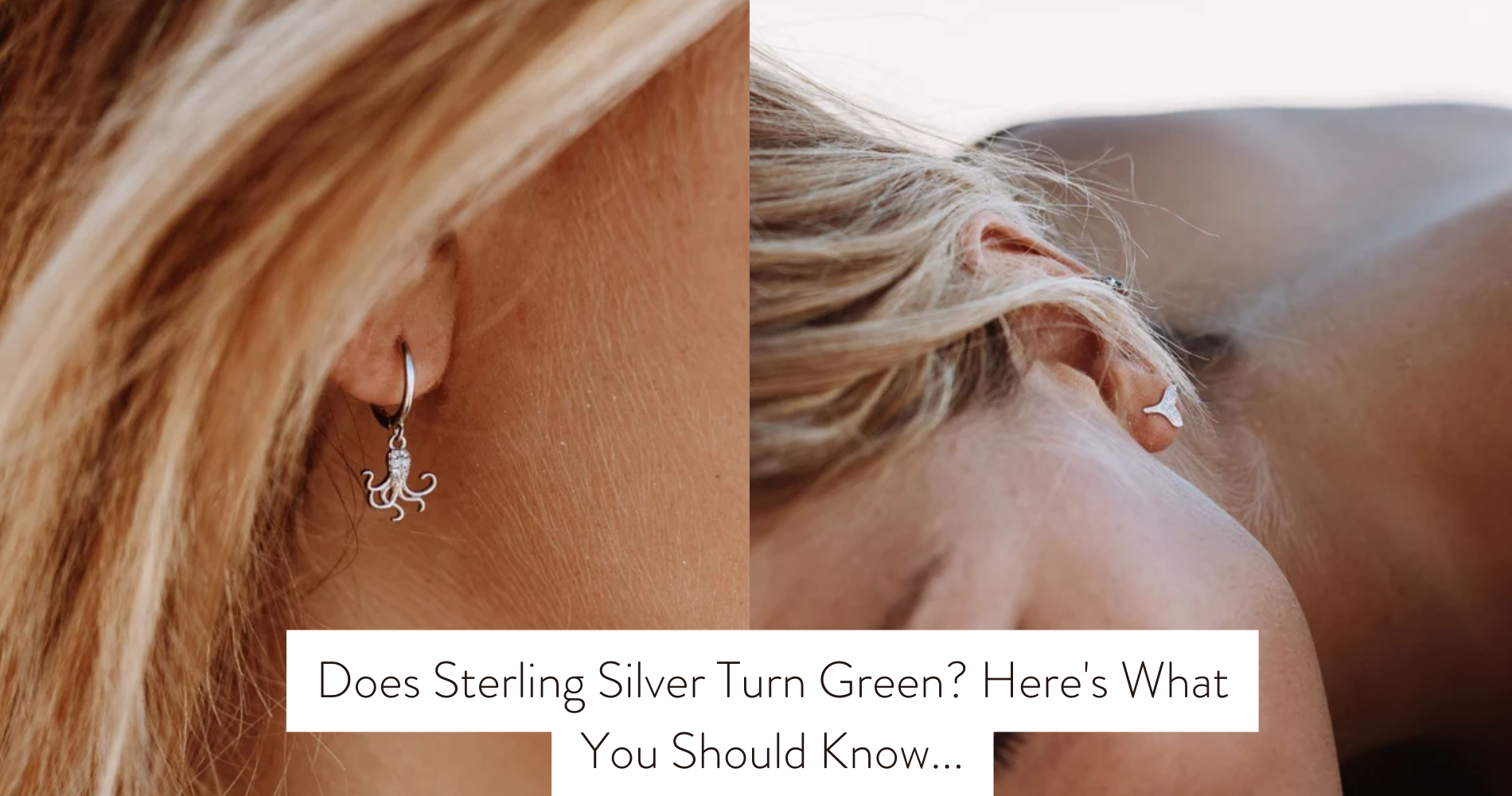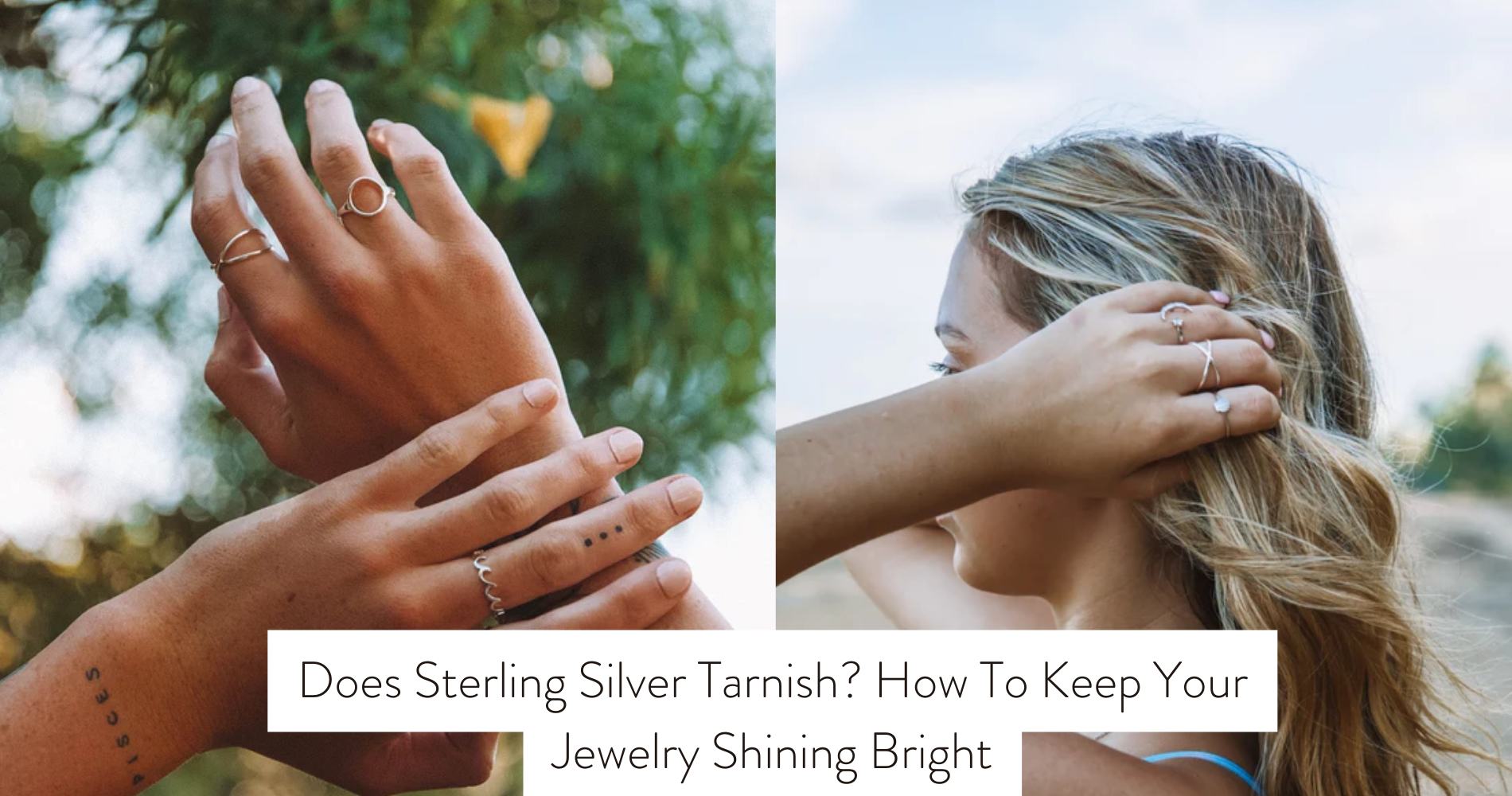
Does Sterling Silver Turn Green? Here's What You Should Know...
Have you ever wondered why sterling silver sometimes turns green, like an old penny left in the rain?
In this article, you will discover what causes this discoloration and learn important tips to prevent it.
Sterling silver is a popular choice for jewelry, but it can tarnish over time due to various factors. By understanding these factors and taking proper care of your silver pieces, you can keep them looking shiny and beautiful for years to come.
From effective cleaning methods to dispelling common myths, this article is your comprehensive guide to preserving the brilliance of your sterling silver jewelry and keeping it free from any greenish tinge — the epitome of tarnish-free jewelry.
What Causes Sterling Silver to Turn Green
If you're wondering why your sterling silver jewelry sometimes turns green, it's likely due to a chemical reaction with substances in the environment. This green discoloration is a common problem that many people face when wearing sterling silver. The main cause of this discoloration is the reaction between the silver and sulfur-containing substances, such as hydrogen sulfide, in the air. When these substances come into contact with the silver, they form a compound called silver sulfide, which has a greenish color.

Chemical reactions occur when the silver reacts with the sulfur-containing substances. This reaction happens because silver is a reactive metal and is easily affected by its surroundings. When the silver comes into contact with substances like sweat, perfume, or lotions that contain sulfur, a chemical reaction takes place, resulting in the green discoloration. The reaction can also be accelerated by exposure to high humidity or by storing the jewelry in a damp environment.
To prevent your sterling silver jewelry from turning green, it's important to minimize its exposure to sulfur-containing substances. Avoid wearing your jewelry while swimming, taking a shower, or applying lotions or perfumes. Store your jewelry in a dry place and clean it regularly using a silver polishing cloth to remove any tarnish or green residue that may have formed.
Understanding the causes of green discoloration and being proactive in taking care of your sterling silver jewelry will ensure that it retains its beautiful shine and color for a long time.
Factors That Contribute to Tarnishing of Sterling Silver
To prevent tarnishing of your sterling silver jewelry, it's important to understand the factors that contribute to its discoloration.
Two significant factors that can cause tarnishing are humidity and certain chemicals.
Humidity plays a major role in the tarnishing process of sterling silver. When exposed to high levels of moisture in the air, such as in humid climates or when stored in damp places, the silver reacts with sulfur compounds to form a layer of tarnish. This layer appears as a dull, yellowish or brownish discoloration on the surface of the silver. Therefore, it's crucial to keep your sterling silver jewelry dry and store it in a cool, dry place to minimize tarnishing.
Certain chemicals can also accelerate the discoloration of sterling silver. Chemicals such as chlorine, bleach, and household cleaning agents contain compounds that can react with the silver and cause tarnish. It's important to avoid exposing your silver jewelry to these chemicals. When engaging in activities such as swimming or cleaning, it's advisable to remove your sterling silver jewelry to prevent contact with these harmful substances.
How to Prevent Sterling Silver From Turning Green
To prevent your sterling silver from turning green, you can take several proactive measures to maintain its shine. The key to preventing tarnish and removing discoloration is regular cleaning and proper storage.
Firstly, make sure to clean your silver jewelry regularly with a soft cloth or a silver polishing cloth. This will help to remove any dirt or oils that can contribute to tarnish. You can also use a mild soap and warm water solution for more thorough cleaning. However, avoid using harsh chemicals or abrasive cleaners as they can damage the surface of the silver.

In addition to cleaning, proper storage is crucial in preventing tarnish. When you're not wearing your sterling silver jewelry, store it in a cool, dry place. Avoid exposing it to air and moisture, as these can accelerate tarnish. Consider using anti-tarnish bags or tarnish-resistant jewelry boxes to protect your silver pieces.
Furthermore, you can also apply a thin layer of clear nail polish to the surface of your sterling silver jewelry. This creates a barrier between the silver and the air, helping to slow down tarnish formation. Just make sure to reapply the nail polish as needed.
Cleaning and Maintenance Tips for Sterling Silver Jewelry
How often should you clean and maintain your sterling silver jewelry? Proper cleaning and maintenance are essential to keep your sterling silver jewelry looking its best. Regular cleaning can help prevent tarnish and keep your jewelry shining. It's recommended to clean your sterling silver jewelry every few months or as needed, depending on how often you wear it.
When cleaning your sterling silver jewelry, there are a few techniques you can use. One popular method is to use a soft cloth or a jewelry cleaning cloth to gently polish the silver. Another option is to use a mild soap and water solution. Simply mix a small amount of mild dish soap with warm water and use a soft brush or cloth to gently clean the jewelry. Be sure to rinse thoroughly and dry with a soft cloth to avoid water spots.
In addition to cleaning, proper storage is also important for maintaining the condition of your sterling silver jewelry. When not wearing your jewelry, store it in a cool, dry place away from direct sunlight. You can also use anti-tarnish strips or pouches to help prevent tarnish. Avoid storing your jewelry in humid areas such as the bathroom, as moisture can accelerate tarnishing.
Other Common Misconceptions About Sterling Silver
If you want to avoid any misunderstandings about sterling silver, it's important to address some of the common misconceptions surrounding this precious metal.
One of the misconceptions is the confusion between sterling silver and silver plated. While both may appear similar, there's a significant difference between the two. Sterling silver is made up of 92.5% pure silver and 7.5% of other metals, usually copper, which gives it strength and durability. On the other hand, silver plated jewelry is made by covering a non-precious base metal with a thin layer of silver. This layer can wear off over time, revealing the base metal underneath.

Another misconception is that sterling silver jewelry is prone to turning green. This isn't entirely true. The green discoloration that sometimes appears on silver jewelry is actually caused by a chemical reaction between the metal and certain substances, such as sweat or cosmetics. However, this reaction isn't exclusive to sterling silver. It can happen with any type of silver jewelry, including silver plated. To prevent this reaction, it's essential to clean and store your sterling silver jewelry properly.
Wearing sterling silver jewelry has numerous benefits. It's hypoallergenic, making it suitable for people with sensitive skin. It's also more affordable compared to other precious metals such as gold or platinum. Additionally, sterling silver jewelry comes in a wide variety of styles and designs, allowing you to express your personal style and enhance your overall look. With proper care, sterling silver jewelry can last for a lifetime, making it a valuable investment.
Frequently Asked Questions
Can Sterling Silver Turn Green if It Comes in Contact With Water?
If you're wondering if sterling silver can turn green when in contact with water, the answer is no. However, it can tarnish faster if exposed to saltwater. Cleaning it with soap and water can help prevent it from turning green.
Are There Any Specific Chemicals or Substances That Can Cause Sterling Silver to Tarnish?
Yes, there are specific chemicals and substances that can cause sterling silver to tarnish. Air is a major factor in tarnishing, but you can prevent it by storing your silver in airtight bags or using anti-tarnish solutions.
How Long Does It Usually Take for Sterling Silver to Turn Green?
To prevent green tarnish on sterling silver, it's important to understand common misconceptions. While it's possible for sterling silver to turn green over time, the speed at which it happens varies depending on factors like exposure to moisture and chemicals.
Is It Possible to Reverse the Green Tarnish on Sterling Silver Jewelry?
Yes, it is possible to reverse the green tarnish on your sterling silver jewelry. Regularly cleaning and polishing your silver can help remove the tarnish and prevent future buildup.
Can Wearing Sterling Silver Jewelry Every Day Speed up the Tarnishing Process?
Wearing sterling silver jewelry every day can speed up its tarnishing process. The level of humidity in the air also affects tarnishing. Keep your silver clean and dry to prevent green tarnish.
Conclusion
In conclusion, while sterling silver may turn green due to various factors, it can be prevented by taking proper care and maintenance. By understanding the causes of tarnishing and following cleaning tips, you can keep your sterling silver jewelry looking beautiful for years to come.
Remember to avoid exposing it to harsh chemicals and moisture, and regularly clean and polish it to maintain its shine. Don't let misconceptions deter you from enjoying the elegance and beauty of sterling silver.



















Leave a comment
This site is protected by hCaptcha and the hCaptcha Privacy Policy and Terms of Service apply.